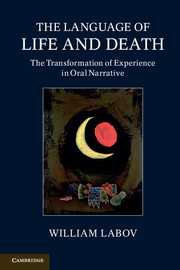Book contents
- Frontmatter
- Contents
- Preface
- Acknowledgments
- 1 Introduction to the language of life and death
- 2 Narrative analysis
- 3 The escalation of violence
- 4 Confrontations with death
- 5 Premonitions and communication with the dead
- 6 Margie Knott: “Her confrontation with the neighbors”
- 7 Gloria Stein: “They stoned the house”
- 8 Rose Norman: “The death of her younger sister”
- 9 Mary Costa: “The death of her youngest daughter”
- 10 Cache County
- 11 The vernacular origin of epic style
- 12 Historians' use of narrative
- 13 Thomas Babington Macaulay: “The death of Monmouth”
- 14 S. T. Bindoff: “The death of Elizabeth”
- 15 2 Samuel: “The death of Absalom”
- 16 The narrative view of death and life
- References
- Index
15 - 2 Samuel: “The death of Absalom”
Published online by Cambridge University Press: 05 June 2013
- Frontmatter
- Contents
- Preface
- Acknowledgments
- 1 Introduction to the language of life and death
- 2 Narrative analysis
- 3 The escalation of violence
- 4 Confrontations with death
- 5 Premonitions and communication with the dead
- 6 Margie Knott: “Her confrontation with the neighbors”
- 7 Gloria Stein: “They stoned the house”
- 8 Rose Norman: “The death of her younger sister”
- 9 Mary Costa: “The death of her youngest daughter”
- 10 Cache County
- 11 The vernacular origin of epic style
- 12 Historians' use of narrative
- 13 Thomas Babington Macaulay: “The death of Monmouth”
- 14 S. T. Bindoff: “The death of Elizabeth”
- 15 2 Samuel: “The death of Absalom”
- 16 The narrative view of death and life
- References
- Index
Summary
The narrative historian who is the subject of this chapter is not known by name. His work is merged into the larger sections of the Old Testament that are sometimes called the “Court History of David.” The particular narratives that we will consider here are found in the second book of Samuel. They display the extraordinary talent of this writer for dramatizing events, with many of the techniques that we have encountered among the most gifted narrators of personal experience. Since he is not named for us, I will refer to him as “the historian” or more specifically as “the OT historian,” since the particular narrative to be considered here bears the mark of a single author in its stylistic and ideological integrity.
That narrative is part of the extended history of David, who succeeded Saul as king of Israel and Judah. It concerns the failed rebellion of David's third son, Absalom. This is the third such event we have encountered; the parallels between Absalom, Monmouth and Essex are remarkable. The “beautiful face and body, brilliant personality and style” of Essex is matched by our OT historian's description of Absalom:
Now in all Israel there was no one to be praised so much for his beauty as Absalom; from the sole of his foot to the crown of his head there was no blemish in him. When he cut the hair of his head (for at the end of every year he used to cut it; when it was heavy on him, he cut it), he weighed the hair of his head, two hundred shekels by the king's weight.
- Type
- Chapter
- Information
- The Language of Life and DeathThe Transformation of Experience in Oral Narrative, pp. 210 - 222Publisher: Cambridge University PressPrint publication year: 2013



